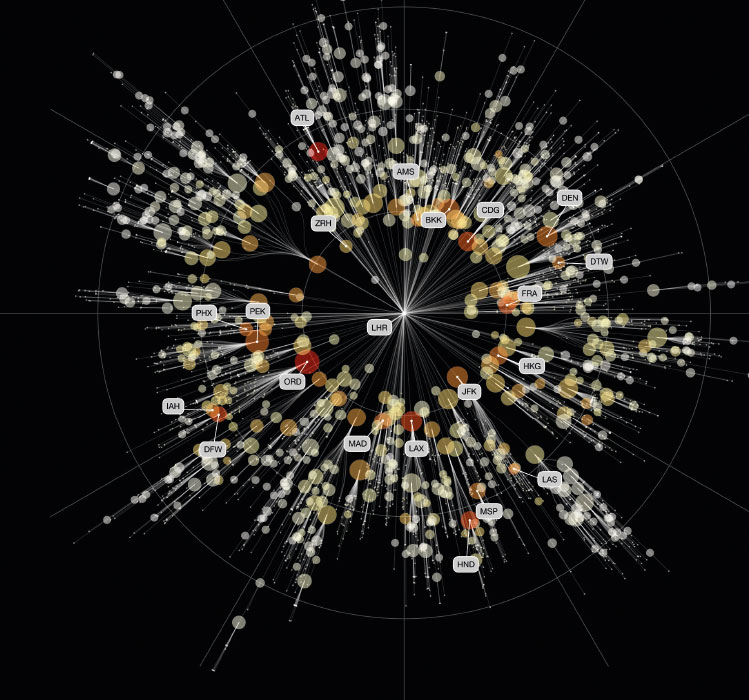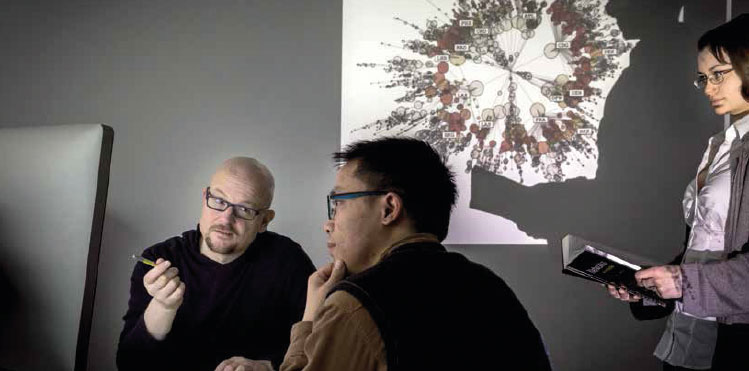
A simulated epidemic wave is here illustrated in the traditional way, using effective, physical distance as means of measuring its spread. But, Professor Dirk Brockmann explained, the global spread of epidemics – and also things such as information, innovation and conflict – is a complex, network-driven process, and as human mobility changes, we may be able to better understand this dynamic by redrawing the maps of our world.
In what has been declared by the World Health Organization (WHO) as an “international health emergency”, the Ebola epidemic has taken an unprecedented hold of the most acutely hit countries of Guinea, Liberia and Sierra Leone – having a far greater impact than all previous Ebola outbreaks combined – and the number of cases is growing “exponentially”. Never before in recorded history, the WHO has said, “has a biosafety level four pathogen infected so many people so quickly, over such a broad geographical area, for so long”.
The Ebola outbreak of 2014 is unlike any past case of the virus. It is the first time that the disease has entered into densely populated urban territories, having previously been confined to rural sub-Saharan regions of Africa. The arrival of infected patient Patrick Sawyer in Lagos, Nigeria’s most populous city, marked the first time that the contagion had been transmitted by a passenger of commercial air travel.
At the time of writing it is two weeks since the first person in the United States was diagnosed with Ebola, after travelling from Liberia to Dallas-Fort Worth in Texas, arriving on 20 September. Thomas Eric Duncan, the patient presently being treated for the virus in Dallas, is said to have flown on United Airlines from Brussels to Washington DC’s Dulles International Airport, before making the final leg of his journey to Dallas-Fort Worth. Since Duncan was displaying no symptoms while flying, authorities have stressed that there is no risk of his fellow passengers having become infected, and it has repeatedly been emphasised that the likelihood of the virus spreading in any significant way via commercial fight is extremely slim. One of the most devastating and appalling aspects of the bloodborne epidemic is its swift onset and the violent brutality with which it assails its victims, while human-to-human transmission is only possible through direct contact with an afflicted person’s bodily fluids.
Nonetheless, the cases – however rare – in which Ebola has been internationally conveyed by commercial flight have given way to the low murmurings of global alarm, and have raised the questions of where else Ebola could go – and what role air travel will play in it going there.
Redrawing the maps of our world
The key to understanding the labyrinthine development of global outbreaks is to consider their movement in the context of the way in which we travel today. Professor Dirk Brockmann of the Robert Koch-Institute in Berlin is world-renowned for his research into the geometry of complex, network-driven contagion phenomena, and analyses the way in which outbreaks spread through the study of human mobility.
Though the patterns of modern disease spread may seem more geographically erratic than they would have done several centuries ago they are not actually more complicated, but are, Brockmann explained, a product of the growing complexity of worldwide mobility. In the 14th century, the Black Death swept across Europe in definitive waves which, although driven by human interaction and mobility, possessed a rather simple structure because people only moved short distances. “We wanted to see if we could understand the complexity of the modern spread of infectious diseases and if it really was more complicated and therefore unpredictable, or whether it’s a simple pattern, just like 400 years ago and it’s just the case that we don’t look at it the right way.”
By making sense of the underlying system which can potentially support the spread – the global air transportation network – Brockmann and his team deduced that global contagion phenomena can be better understood by redrawing the maps of our world. “Places such as London, or Paris, or New York were hubs centuries ago, but trade was local, and mobility was local. Nowadays, these hubs – important places in the world – are very interconnected. If you look at the world from the perspective of London, say, you have very strong connections to other metropolitan areas in the US or Asia or Africa that lots of people travel between, and that generates the complexity that we see in the spread of infectious diseases,” Brockmann stated. “For the modern world, where everything is connected over very long-range distances, we need to replace the conventional view and conventional use of geographic distance, to instead make predictions by a measure that reflects connectivity today.”
Brockmann’s pioneering map for the mobility of today takes an intuitive stance, replacing physical distance with a more effective kind of measure that resembles traffic and frequency. The more traffic there is, the shorter the distance between two places. “Imagine that you’re in London,” he said. “Lots of people move from London to other busy places like New York or Los Angeles, while far fewer people travel from London to say, a remote village in Scotland. Now the village in Scotland is geographically very close, while the big hubs like Los Angeles and New York are far away, but connected to London in a much stronger way. So intuitively it would maybe make sense to redraw the map in such a way that places like New York and Los Angeles are closer to London than the remote village in Scotland.” A similar map of connections could be plotted for each of the airports in the world’s air transportation infrastructure, creating a network of thousands of airports and many more thousands of connections that document the way we traverse distances today.
This research is the foundation of a mathematical theory that provides powerful insight into outbreak’s future reach, and brings a level of predictability to diseases’ seemingly chaotic spread that has enabled Brockmann to develop an interactive network analysis of the relative import risk and most probable spreading routes of Ebola. Using computational, quantitative epidemiology, Brockmann has interpreted and estimated the risk of the virus spreading from major airports in the affected countries of Guinea, Sierra Leone, Liberia, Senegal and Nigeria to other regions of the world as induced by global mobility. Using the probability that a patient boards a plane at an outbreak location, multiplied by the probability that the patient takes one among very many possible routes to a destination and gets off the plane, he can work out the Relative Import Probability, or the probability that an infected individual arrives at any location in the worldwide air-transportation network. His forecast can demonstrate, for example, that there is a Relative Import Probability of 3.69% of the disease moving from Freetown to London Heathrow, while of it being transmitted from Dakar to Brussels Airport there is a 5.1% relative import probability. The actual import risk is greatly lower than the relative import risk, which is useful for comparing different locations, but alone does not predict the import probability at a certain destination.
“So what’s going on is not that the spread of infectious diseases is in any way more complicated nowadays, it’s just that its complexity is hidden in the complexity of the air transportation network,” Brockmann said. “If we introduce a more practical, or more suitable, way of thinking of distance, everything becomes just as predictable as the outbreaks of the past centuries.”
The most recent research project led by the Robert Koch Institute is entitled AIRSAN. The project aims to support EU Member States in ensuring a well-organised and coherent response to public health threats in air transport. ACI EUROPE is one of the associated partners of the project.
The role that airports play

Professor Brockmann’s pioneering map, more suited to the way we travel today, takes an intuitive stance, replacing physical distance with a more effective kind of measure that resembles traffic and frequency – the more traffic there is, the shorter the distance between two places. Global links, major and minor, to London’s Heathrow Airport, are plotted here in terms of their connectivity to, rather than distance from, the UK hub.

Professor Dirk Brockmann of the Robert Koch-Institute, Berlin: “For the modern world, where everything is connected over very long-range distances, we need to replace the conventional view and conventional use of geographic distance, to instead make predictions by a measure that reflects connectivity today.”
With the phenomena of contagions far expedited by the complex air transport networks of our globally connected age, each of the parties with a stake in the passenger journey has a role to play in the safety of not only travellers, but everyone with whom they may come into contact.
The authorities of the countries most severely afflicted by the outbreak of Ebola have introduced health checks upon departure from their airports that include temperature checks for fever, while passengers must also fill out a form stating that they have no symptoms of the disease. In the event of a suspected case of the disease, the passenger will be denied boarding. Should a suspected case become apparent during a flight, the airline crew members will alert the emergency medical services who, in turn, will alert the airport medical services. The person or persons concerned will then be taken on arrival to be diagnosed and, if necessary, transferred to the appropriate facilities. At the destination airport the rest of the passengers will be subject to ‘tracing’ – the completion of an information sheet with contact details and seat number onboard before leaving the aircraft.
Amid the most acute epidemic in our recent history, the pivotal role of Europe’s gateways is primarily to reassure its passengers and staff through information. Many airports across the EU are engaged in information campaigns and working closely with their national health authorities.
For instance, in accordance with the request of the French Ministry of Social Affairs and Health, Aéroports de Paris has set up an information campaign to inform passengers in the arrivals and departures areas of all terminals at Paris-Charles de Gaulle and Paris-Orly. Amsterdam Schiphol Airport provides passengers flying to Lagos on its twice-daily flights with information about Ebola and the risks, and what, in particular to avoid. Passengers who arrive in the Netherlands from Lagos are checked for fever, and also receive information about Ebola. Brussels Airport, meanwhile, which has strong links with Africa due to its colonial connections to the continent, was immediately concerned by the dangers of the epidemic. Working alongside the Belgian Ministry of Health and Brussels Airlines, it provides a comprehensive catalogue of information to its passengers via its website, which has a dedicated section devoted to precautions to take in instances of Ebola.
View Dirk Brockmann’s ‘Ebola Outbreak: Worldwide Air Transportation and Relative Import Risk’ interactive network analysis:
http://rocs.hu-berlin.de/D3/ebola/
ACI EUROPE’S ACTION ON EBOLA
Airports’ preparedness for outbreaks is a regular subject for discussion in the ACI EUROPE Facilitation and Customer Services Committee’s meetings. In the case of the current spread of Ebola, ACI EUROPE has been tracking the outbreak since it began and reminded members of their obligations under international Health regulations. It also issued regular updates to its members with all the various risks assessments of the Ebola outbreak provided by the European Centre for Disease Prevention and Control (ECDC) and the World Health Organization (WHO).
In addition, ACI EUROPE Director General Olivier Jankovec has actively participated in the European Aviation Crisis Coordination Cell (EACCC)’s work on Ebola over the summer, while Facilitation and Communications departments of the largest European airports and hubs also received updates from ACI EUROPE.







